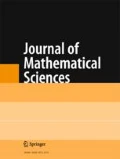Let \( \tilde{G} \) be a reductive algebraic group, which is defined and split over a field K. Here the Zariski open subset \( \mathfrak{B} \) of the group \( \tilde{G} \) that consists of elements such that their conjugacy classes intersect the Big Bruhat Cell is considered. In particular, a description is given for the set \( \mathfrak{B}(K) \) in the case \( \tilde{G} = {\text{G}}{{\text{L}}_n} \), SL n . Bibliography: 16 titles.
Similar content being viewed by others
References
A. Borel, Linear Algebraic groups, 2nd enl. ed., Graduate texts in mathematics, 126, Springer-Verlag, New York (1991).
N. Bourbaki, Éléments de Mathématique. Groupes et Algèbres de Lie, Chaps. IV, V, VI, 2ème èd., Masson, Paris (1981).
R. W. Carter, Finite Groups of Lie Type. Conjugacy Classes and Complex Characters, John Wiley & Sons, Chichester et al. (1985).
Key Yuen Chan, Jiang-Hua, and Simon Kai Ming To, “On intersections of conjugacy classes and Bruhat cells,” Transformation groups, 15(2), 243–260 (2010).
E. W. Ellers and N. Gordeev, “Intersection of conjugacy classes with Bruhat cells in Chevalley groups,” Pacific J. Math., 214(2), 245–261 (2004).
E. W. Ellers and N. Gordeev, “Intersection of conjugacy classes with Bruhat cells in Chevalley groups: The cases SL n (K), GL n (K),” J. Pure Appl. Algebra, 209, 703–723 (2007).
J. E. Humphreys, Linear Algebraic Groups, Graduate Texts in Mathematics, 21, Springer-Verlag, New York–Heidelberg–Berlin (1975).
N. Kawanaka, “Unipotent elements and characters of finite Chevalley groups,” Osaka J. Math., 12(2), 523–554 (1975).
G. Lusztig, “From conjugacy classes in the Weyl group to unipotent classes,” arxiv:1003.0412v4 (2010).
G. Lusztig, “On C-small conjugacy classes in a reductive group,” arxiv:1005:4313v1 (2010).
J. N. Spaltenstein, “Classes unipotentes et sous-groupes de Borel,” Lect. Notes Math., 946, Springer-Verlag, Berlin–Heidelberg–New York (1980).
T. A. Springer, Linear Algebraic Groups, 2nd ed., Progress in Mathematics, 9, Birkhäuser Boston, Boston (1998).
T. A. Springer and R. Steinberg, “Conjugacy classes,” Lect. Notes Math., 131, Springer-Verlag, Berlin–Heidelberg–New York (1970).
R. Steinberg, “Regular elements of semisimple algebraic groups,” Inst. Hautes Études Sci. Publ. Math., 25, 49–80 (1965).
N. A. Vavilov, “Bruhat decomposition of two-dimensional transformations,” Vestn. Leningrad. Univ., Mat. Mekh. Astr., 3, 3–7 (1989).
N. A. Vavilov and A. A. Semenov, “Bruhat decomposition for long root tori in Chevalley groups,” Zap. Nauchn. Semin. LOMI, 175, 12–23 (1989).
Author information
Authors and Affiliations
Corresponding author
Additional information
Published in Zapiski Nauchnykh Seminarov POMI, Vol. 386, 2011, pp. 203–226.
Rights and permissions
About this article
Cite this article
Gordeev, N.L., Ellers, E.W. Big and small elements in Chevalley groups. J Math Sci 180, 315–329 (2012). https://doi.org/10.1007/s10958-011-0645-7
Received:
Published:
Issue Date:
DOI: https://doi.org/10.1007/s10958-011-0645-7


